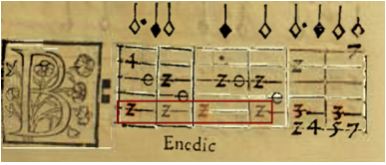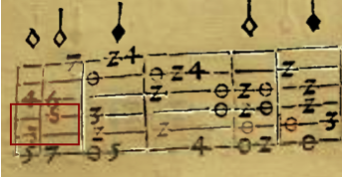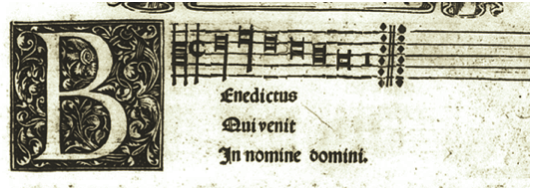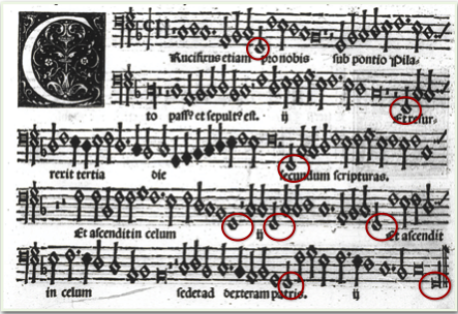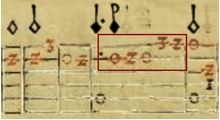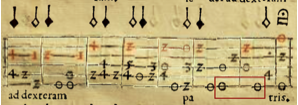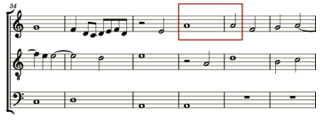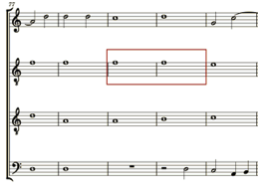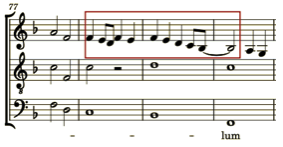- Decision according to the number of notes: this recommendation might seem almost contradictory to the first one, but it is rather a methodical continuation of the experience already gained. According to the total number of notes contained in the composition, we decide the position of the lowest of them on one of the seven vihuelas. Bermudo offers very detailed description:
- Range of twelve notes: the lowest note of the bass should be placed on the fifth string, third or fourth fret, and the range will go up to the same fret of the first string
- Range of thirteen notes: the lowest not of the bass should be placed on the fifth string on the first of second fret
- Range of fourteen notes: the lowest note of the bass should be placed on the open fifth string
- Range of fifteen notes: the lowest note of the bass should be placed on the on the third of fourth fret of the sixth string
- Range of sixteen notes: the lowest note of the bass should be placed on the second or third fret of the sixth string
- Range of seventeen notes: the lowest note of the bass should be placed on first of second fret of the sixth string
- Range of eighteen notes: the lowest note of the bass should be placed on the open sixth string100
- Decision according to the placement of the highest note: This recommendation is describing the placement of the highest note on the first string. In order to play the music easily, we should put the highest tone up to the fifth fret, or if necessary, to the sixth or seventh fret of the first string. In practice, we encounter some cases where the placement of the highest note on the first string extends beyond the seventh fret. We have to take into consideration that these instructions are really for beginners and Bermudo wants to avoid misplacing the piece onto the vihuela. Another aspect he points out is the difficulty of tuning in the higher position of the fretboard due to possible misplacement of the frets according the tuning instructions he offers in upcoming chapters.
- 101 As Bermudo is mentioning, rarely does a composition go beyond the tenth fret, and normally the vihuela does not need more then this number of frets.102 Additionally, all his drawn vihuelas ends on tenth position.
In addition to the three recommendations mentioned above regarding the decision for which vihuela the composition should be intabulated, Bermudo offers one more option to consider in the 71st chapter entitled De ciertos avisos para la conclusion del cifrar (Some concluding recommendations on intabulation). After placing the music in the score, we should find out if any notes are in unison in two voice parts. If possible, they should be arranged both on one open string, because if one is placed on an open string, the other will be placed on the lower string at the fret that forms a unison with the upper string (according the tuning system of vihuela it will be fourth or fifth fret of the lower string). If this is not technically feasible, another possibility is to place the second note on the same place as the first one, as an organ player would do. This situation is illustrated in the example below, wherein a fragment of intabulated Benedictus from Missa Mille regretz by Cristóbal de Morales, we observe the decision of Fuenllana to put the unison on the open second string, allowing the vihuela to resonate both voices simultaneously. By using an open string, the middle voice still sounds even when the cantus changes tone on the other beat. Bermudo is known to favor purity of playing over a technically unmanageable situation so long as the clarity of the polyphonic writing is kept.103
For those who are more experienced with intabulating, Bermudo proposes an option where the intabulation is derived directly from the choir book. This process is designed especially for: “good musicians, willing to make a bit of effort to get good results”.106 Another step and possibility is to achieve such perfection in the understanding that it will be possible to play the music directly from choir books without prior intabulation. Bermudo himself refers to the topic of playing directly from choir books also in chapters connected with playing music on a keyboard instrument in Declaración de los instrumentos, fol lxxxii:
“…having a book of polyphony in front of one. He who wants to be a performer - if he is a good singer who knows about composition - by studying what is in this book and understanding the keyboard can play works on it with only having the book in font of him. This way of playing is very laborious, for there is a lot of counting, when looking at all the parts, but it is very profitable; one can make a lot of music this way.”107
From other Spanish sources, it is known that musicians were expected to have astonishing reading skills in certain circumstances. For example, within Bernardo Clavijo del Castillo’s examination for the professorship at the University of Salamanca or for the organist position at Málaga Cathedral, where the sight-reading abilities were tested extensively as Anne Smith is describing in her book The Performance of 16th-Century Music.108
After the first preparation phase, where it is decided for which vihuela the piece will be intabulated and the parts were put into the score, we can start with the intabulating process itself. First of all, Bermudo suggests to place the name of the author above to give to the intabulated piece “great value and quality”. The next step is to specify the mode of the composition and decide a clef. Especially in the case of transposition, we should specify the clef.109 The placement of the clef is also used to determine for which of the seven vihuelas the piece was intabulated. However, Bermudo alerts us to common clef placement errors when copying frequently. If the mode of the piece is not obvious from tablature, we need to look at where the semitone is formed on any of the strings. Bermudo explains this process below:
“I mean that if there were a zero on the third string and then one [immediately] or later after it on the same string, you will know that the two ciphers form a semitone; then, the third string open is mi. That [piece] was intabulated for the vihuela in Are, on which the third string open is the mi or b fa mi. If on the first string there is a semitone, begin counting the frets downward until you find which note that string is tuned to, and this way you will be able to tell for which drawn vihuela the music was intabulated.”110
Juan Bermudo is using the Italian system of tablature, (i.e. open upper line indicates the lowest string, use of numerical system, where open string is indicated by zero, continuing with Arabic numbers). However, in the following chapter, Bermudo also lists other types of tablatures that a player may encounter outside of the the present book.111 If the player is not satisfied with any of the above mentioned systems, he may invent another, or better yet, improve the old system.112 Bermudo continues with a detailed description of the numeric system of tablatures and rhythmic signs emphasizing that a particular sign does not show the value in all the parts, but of the part that has the most ciphers.
Once the player understands all the above rules and recommendations, he should be able to transcribe the intabulation back into notation as faithfully as it was written before the intabulation itself.
In the case of syncopations, Bermudo suggests a similar strategy. Syncopated notes, when they cross the bar line, they should be notated and ciphered in both measures and above those two notes a fermata is placed and the following two ciphers should be plucked just once. As Bermudo advises to also place the notation above the intabulation and he is replacing the rhythmic marking, the fermata is mostly an indication of the singing line. Unfortunately, no further explanation of re-striking is included in the Declaración de los instrumentos. Bermudo’s advice is followed only by warnings concerning the position and clarity of the intabulation.114 Regarding the intabulations by Miguel de Fuenllana, we see that the use of the fermata is partially different. Firstly, their use is not so frequent as it would be if Fuenllana strictly followed Bermudo’s instructions. Also, the fermata does not explicitly connect two notes of the same pitch, it only extends the length of the previous note, as we can see in the example below. Other examples are possible to find in the attachment.
Already in the first bars of the intabulation we can observe that Fuenllana resolved this situation by re-striking the note with every bar line, which preserves the presence of the tone. Fuenllana decided to color the altus line, so altus is supposed to be sung in this case. This is another way of ensuring that the sound is prolonged on the vihuela.
In some instances, Fuenllana uses the re-striking technique to accentuate dissonance within the cadence. In the intabulation of Crucifixus de la Missa Tu es vas electionis we can encounter this case twice in the second half of the piece. From a practical point of view, Fuenllana divides the brevis into semibrevis with an augmentation dot and minima to emphasize the leading voice of the cadence.
As the number of polyphonic voices increases in accordance with the difficulty, the embellishments decreases, as we can trace through the chapters in Orphénica Lyra. What the actual performance practice was is discussable. As John Griffiths mentioned in the article The vihuela: performance, practice, style and context:
“It must be remembered that all their writers are expressing their personal preference and taste and in so doing all are also tacitly acknowledging a practice of embellishing intabulated vocal pieces.”130
In the following table we can see the list of the intabulations of the pieces by Cristóbal de Morales included in Fuenllana's Orphénice Lyra, where we can demonstrate the process of deciding for which (drawn) vihuela the intabulation was intended. I compared the position of the tone in the intabulation with the vocal original contained in the facsimile.
The following example from the same piece demonstrates the use of the augmentation dotted note within one bar without the re-strike. Comparing this situation with the vocal original, there would be no syllables to sing, so the second of the tied notes would not be pronounced. Of course, on the instrument it is not always the case.
In some cases the decision of the placement of the note being re-struck is necessary to adjust to the placement of the other voices and technical possibilities of the fingering. In this case, it may be worth considering placing the tone on a different string in a higher position to avoid technical difficulty, as we can see on the following example:
In some cases, diminutions also occur in out-of-cadence situations, when the composition requires it, as was mentioned by Fuenllana. On the musical instrument such as vihuela or lute, by adding diminution, it becomes easier to control dynamic possibilities of the melodic line, as may be the case of the beginning of the intabulation of Benedictus de la Missa Mille Regretz.
- Musica ficta:
Musica ficta is an essential concept in understanding historically informed performance practice. According to the Brittanica dictionary, musica ficta can be defined as:
“…notes that were not included within the gamut first authorized by the Italian theorist Guido d’Arezzo in the early 11th century. The opposite of musica ficta was musica recta, which included only the recognized notes” 131
The use of musica ficta was highly dependent on the regional and personal taste of each school in the sixteenth century. In the Spanish style, musica ficta was used to introduce and apply accidentals and other nuances, resulting in an exotic, uniquely Spanish sound.132 While in vocal notation musica ficta was generally left to the performer, instrumental tablatures constitute the largest body of evidence about the way sixteenth-century musicians applied musica ficta in actual practice. The precise right hand position indication on the fingerboard during the process of intabulating vocal pieces makes this regional use of musica ficta unquestionable. We can assume that this use of accidentals can be applied to vocal performance too. Some treatises on embellishment make clear that the same kinds of ornaments were meant to be sung as well as played. As Ganassi even mentioned, instrumentalists should imitate singers in every possible way, which in literal interpretation can be applied to the use of musica ficta as well.133
To exemplify the use of musica ficta in the intabulations of Miguel de Fuenllana, I have chosen the following examples:
Vincenzo Galilei in his treatise Fronimo (1584) provides additional information concerning re-struck notes. On the example of brevis he suggests a general rule, implicating that we should strike the brevis again at the beginning of the measure,115 especially in addition to keeping the “harmonious consonances” because it would not be possible to make it sound fully without the repercussion.116 Galilei points to certain risks:
“But I say, indeed, that to repeat the note without reason and when it is not necessary would cause the refined ear no little annoyance; besides, it would conceal the imitations in the places where they exist and deprive many passages of lightness; …” 117
An essential component of re-striking the notes is to preserve the sonority of the instrument. In the case of long note values, the sonority on a plucked instrument is very limited. Galilei points out this problem in the case of the repercussion of a note with an augmentation dot,118 although this reason for repetition of the cipher can be used more generally. Evidence of conscious sound prolongation can be demonstrated by the example of Fuenllana's intabulation Benedictus de la Missa L’Homme armé by Cristóbal de Morales. In the altus of this four-part piece appears repeated cantus firmus:
- Place the music in front of you
The common practice in the 16th century was that music appeared either in choir-books with each part carefully notated individually or in part books, where each part had its own book.104 For a beginner, it would be of course difficult to intabulate music directly from parts. The music which will be intabulated should be placed into a score marked with bar lines, which will divide the measures both in the tablature as well as in the notation to help with the player’s orientation.105 To make the intabulation process clear at the beginning, it is possible to leave the part notated above the intabulation itself. In this case it is not necessary to use signs of rhythmic duration in the tablature. Here we have two options as well. We can leave all the the voice parts, or we can notate the voice which will be sung. In case we do not leave the voice part written above the intabulation, we have several options in notating the vocal line, such as colored numbers or systems of dots or commas. More detailed information about the singing lines as part of the intabulation will be discussed later.
- Embellishments
While ornamentation and improvisation has an important role in lute and vihuela performance, the Spanish process of intabulating sacred vocal pieces is different from that of other European countries. However, this distinction of use of diminutions by nation is not accurate. If we take the example of Spanish composers such as Diego Ortiz, Antonio Cabezón and also some of the variations on hymn melodies and a basse dances included in the books of other vihuela players, such as Luis de Narváez we see a wide variety in diminutions.123 Speaking now mainly about the intabulations of sacred vocal pieces for plucked instruments, in comparison with almost wild diminutive intabulations of lutenists such as Vincenzo Capirola or Francesco Spinacino, the manner of the Spanish vihuelists is an almost ascetic and literal way of intabulation with a minimum of added diminutions. The overuse of ornamentation in intabulations of vocal pieces and adding too many tasteless glossas124 is described in Bermudo’s view as the aforementioned Barbarismos musicales (together with playing incorrect tempos, using the wrong accidentals in a mode).125 Bermudo is not the only one who criticizes wild application of diminution. Gioseffo Zarlino in his Institutioni harmonische (1558) makes a strong statement against singers who applied the diminutions which are wild and out of proportion and disturb the listeners and create many errors.126 Generally speaking, the overuse of diminutions may cause a confusion within the piece.
Also Miguel de Fuenllana in his preface (fol.V) admonishes the use of excessive embellishment in intabulations:
“I do not always put glossas on composed works, because I am not of the opinion that with glossas or redobles is hidden, as we see, that some people, content with their own opinion, they compose again the works that very good authors have composed with excellent artifice and good spirit surrounding the works with so many redobles,127 ordered at their will. I say, that if it were not offered by cadence, or at a time the composition itself would not require it, one should not in any way defraud the composition with such glossas or redobles, and as I have said, because of the cadence I have mentioned here, I do not put [redobles] in the works of this book, except to the case of cadences, or in the places that the composition demands it, as in the works themselves you will see.” 128
Fuenllana's statement about “destroying already perfect polyphonic composition” can also be supported by an apocryphal anecdote from 1562, in which Josquin de Prez recounts his intolerance of embellishments:
“When he heard a singer ornamenting one of his compositions, he went up to him and said: you ass, why do you add embellishments? If I had wanted them, I would have written them myself. If you wish to improve on finished compositions make your own, but leave mine unimproved.”129
If we want to use any kind of embellishment in an intabulated vocal piece, it is important that its use never gets in the way of clarity of the polyphony. As Fuenllana suggests, one of the suitable places is cadence, as we can see in following examples:
Other Points of Interest in the Intabulating Process:
As already mentioned above, the intabulation is often a source of important information, which may not appear in the original facsimile, but is relevant for performance or intabulating practice. In this chapter we will compare three pieces written by Cristóbal de Morales intabulated by Miguel de Fuenllana: Benedictus de la Missa Mille Regretz, Crucifixus de la Missa Tu es vas electionis, and Benedictus de la Missa L’Homme Armé with the original vocal notation.
The difference between the Italian and the Spanish schools of intabulations in particular needs to be emphasized. While the Italian school works with a rich diminutive technique, the Spanish vihuela school of intabulating sacred works is more literal, as we can prove, for example, in the works intabulated by Miguel de Fuenllana, but also by other vihuelists. Some aspects of intabulation have already have been mentioned in the previous chapter. The focus will be in particular on the following:
- Re-striking of dotted notes of notes of longer values
- The vocal line
- Embellishment
- Musica ficta
- Re-striking of dotted notes of notes of longer values
One aspect that often appears in intabulation, and which requires careful attention, is the frequent re-striking in the case of dotted note or notes of longer values. In most cases the note is re-struck if the length of the note exceeds the bar line. It should be noted that the use of this phenomenon is not always consistent within the intabulated piece. Juan Bermudo in Declaración de los intrumentos musicales describes the intabulation process in the case of augmentation dots and syncopated notes. Since this explanation of the phenomenon of the re-striking is insufficient, as another source for the explanation Fronimo (1584) written by Vincenzo Galilei will be employed.
The augmentation dot:
In chapter 71, Juan Bermudo describes very basic rules of placement and use of the augmentation dots. It should noted that this treatise was intended primarily for beginners. In the case of the augmentation dots, Bermudo offers the following instruction:
“If that dot goes over into another measure, place the dot after the bar line, in the following measure, and do not cipher it, nor hide it. It is done this way so that it is not pronounced and is played on the stroke of the note to which it is affixed.”113
Bermudo recommends not repeating a note even if it is within the same measure. This information is partly contradictory compared to the practice as we can see in several examples of the intabulations by Miguel de Fuenllana (and also by other vihuelists, who are not included in this thesis as the mains source). In the following example from Benedictus de la Missa Mille Regretz, it is possible to demonstrate the case of the dotted not crossing the bar line:
- The vocal line:
It is common practice for the text to appear in the intabulations of the vocal repertoire accompanied by the marked (colored) vocal line. The importance of preserving the sung text is demonstrated by this excerpt from the preface of Fuenllana’s Orphénica Lyra:
“It was my intention to give the words [of the works], as it seems to me that the words are the soul of any composition; for although a piece of music may have great merit, without the words it lacks real spirit. And as I have said I though it better to give the words and to indicate that part which was the most suitable for singing, by putting it in red numerals. If the student of these works pays attention to this instruction, and to others which will be given later, he will be enambled to taste the delights of singing one of the parts of the work which he is playing.”119
In the examples of Fuenllana’s intabulations we can see that the choice of vocal part varies from piece to piece as it is already in the three examples mentioned above (Benedictus de la Missa Mille regretz, Crucifixus de la Missa Tu es vas electionis and Benedictus de la Missa L’Homme Armé). In the case of the Benedictus de la Missa L’Homme Armé, the decision of coloring the altus is linked to the practical use for the sound extension of the cantus firumus (see above). In the other two examples, Fuenllana decided to color bassus. The reason for this decision may be related to the aesthetic aspect, or to the pitch of the vihuelist’s voice itself. Other potential considerations may be pedagogical intention for better clarity and understanding of the polyphonic part. Bermudo mentions in the Declaración de los instrumentos musicales:
“Some [players] want to recognize the voice-parts in the tablature, so that they can sing [along] on whichever part they like, or better enjoy the music, seeing how the parts fit together.”120
It is important to mention that Bermudo is not using the same way of marking the voice line as Funellana. Bermudo prefers the way of indicating the notated polyphonic parts above the tablature to avoid confusion.121 In some cases, Fuenllana also leaves the notated part above the tablature, as we can see on the example of intabulation of Lamentaciones by Cristóbal de Morales. In this example, the singing line is not a part of the intabulation. A voice line marked in this way appears especially in the case of intabulations of more then five voice polyphony to avoid increasing technical difficulty.122
he Process of Intabulation according to Bermudo
This chapter will provide basic instructions on how to intabulate a piece, but most importantly, how to understand the intabulation process. As we are focusing on music of 16th century Spain, one of the best available sources is Declaración de los instrumentos musicales (1555) written by Fray Juan Bermudo. Declaración is Bermudo’s third publication, though material from both previous books (El libro primero de la declaración de los instrumentos; 1549 and Ei arte tripharia; 1550) is present also in the third one, which was intended as a one-volume collection of his writing. All three treatises were published in Osuna by Juan de León. Bermudo wrote this treatise for both amateurs and experienced musicians as a theoretical guideline. According to Bermudo, the standard of making music in Spain was quite low and he wanted to educate instrumentalists in matters beyond musical practice and to avoid barbarismos musicales such as playing incorrect tempos, using wrong accidentals in modes, adding too many and tasteless ornaments in intabulations of vocal pieces, etc. As his book is intended for practical use for instrumentalists as opposed to theorists, he wrote it in Spanish, rather in Latin and every section begins with a brief prologue “to the attentive reader”, wherein he explain his intentions.87 It is clear that this is not just an anthology of tablatures and music, but a treatise on many aspects of the history, science, and art of music, formulated with a clear educational aim for readers.88 The last treatise Declaración de los instrumentos musicales is divided into the following five books:
- Book 1: Alabanças de musica (In praise of music) - 20 chapters (fols. 1-20r)
- Book 2: Covering the rudiments of music - 36 chapters (fols. 20v-30v)
- Book 3: Covering plainchant and vocal polyphony - 29 chapters (fols. 21r-60r)
- Book 4: Without general title, but titled by section - 93 chapters
(a) De tañer organo (On playing the organ) - chapters 1-53 (fols. 60r-91r)
(b) De tañer vihuela (On playing the vihuela) - chapters 54-86 (fols. 90v-110r)
(c) De tañer harpa (On playing the harp) - chapters 87-93 (fols 110v-113v)
(d) De tañer organo (On playing the organ) with additional section with musical examples inchoirbook (fols. 114r-120r)
- Book 5: De composicion (On composition) - 33 chapters (fols. 120v-142v).89
This chapter will be dedicated predominantly to a section De tañer vihuela (On playing vihuela) from fourth book, especially on instructions regarding the process of intabulating (mostly chapters 70-74).90 The previous chapters have dealt mainly with tuning and general descriptions of vihuela and related instruments such as bandurria or guitars. Bermudo gives us very detailed advice guiding us through the entire intabulating process in a very practical manner in order to deepen one's musical understanding. The essential advice for all instrumentalists is that they should learn by assimilating techniques derived from vocal music. The close interconnection between instrumental and vocal music must be evident both in the musical presentation, and the pedagogical approach.91 As Bermudo writes himself in chapter 71:
“Players are often guilty of wanting to play fantasies when they are just starting to play. Even though they may know counterpoint, unless [this counterpoint] is as good as that of the abovementioned musicians, they should not play fantasies too soon, so as not to form bad habits.” 92
This is a very different approach from the previously published pedagogically oriented vihuela book El Maestro by Luis Milán published twenty years before Bermudo’s book. Milán's approach was entirely opposite to Bermudo’s in that it was based mostly on playing fantasías. Tablature books came into play as an instructional methodology for self-taught musicians. Tablatures allowed amateur musicians to focus not on the intellectual comprehension and appreciation of music, but on the technical basics of music performance.93 This development should help us in understanding the musical and pedagogical background of musicians in this period. The above examples of self-instructive literature reflect the real practice of master-to-student teaching. Hopefully, this could lead to further development of historically informed pedagogy.
According Bermudo, the best way for aspiring vihuelists to learn the instrument is based on a solid understanding of vocal polyphony, compositional techniques of renowned authors of the time and, of course, good taste. What he also advises before embarking on the intabulating process itself is to properly understand tuning of instruments and their fret placement. For this purpose he uses seven drawn vihuelas in different tunings, which could serve as guidelines for placing the given vocal template onto the vihuela. There are two potential processes we can follow, according to the relationship between the fingerboard of the vihuela and the original pitch of the vocal piece, as Bermudo explains in the beginning of the Libro Quatro of the Declaración:
“ …Inquisitive players of the vihuela choose one of two practices in this respect: either they change the music to suit the instrument, or they change the instrument to suit the music. Let it be clear: it is a single instrument and it notes are fixed, and should the music be out of the key when responding to a choir, or for some other reasons that vihuelist might have, they change the music. Thus, there are some vihuela players who always think of the vihuela as being in a fixed tuning, and if the music should not agree with their conception of the instrument, because it goes beyond the range of the frets, they transpose the music so that it can be comfortably played. This way of playing the vihuela used to be more common than it is now and there were players with great facility even if they were not as wise as those who these days use many vihuelas. I deal with this subject following this present overview in chapter eighty-two. Those who did not know how to shift their frets used this way of intabulating on the vihuela and for their needs it was good. These days there are musicians who, not content with changing the music to suit the vihuela prefer to leave it as they find it and change the vihuela by not always imagining the Sixth course to be one pitch, but pretend to raise or lower it according to the music. They imagine, then, the lowest note of the vihuela sometimes to. Be G, other times A, and thus on all of the seven different notes, and even sometimes on chromatic semitones. This is what good players do, and you will encounter it in both Spanish and foreign tablatures.” 94
What is important to realize is that Bermudo is speaking about the process, not about the result. Whether we “change the instrument for the music” or “change the music for the instrument” the result will sound the same. The process of not transposing the music in advance seems to be more universal in praxis. It is advised to be familiar with both systems in order to have a comprehensive understanding of music. Nevertheless, if we are owners of one or two instruments, we are very limited in the number of possible final pitches, as we want to keep the tuning system. The most suitable system for tuning, according Bermudo, is the Pythagorian tuning.95 In addition to this advice, he also gives us very detailed instructions on how to tune our instrument and a suggestion to keep as many open strings as possible. This is important not only in avoiding technical difficulties for the player, but also to achieve maximal acoustic resonance on the instrument.
- Decision according to the bass note: this first recommendation determines the easiest part of decision making, as Bermudo’s usual method of presentation is from simple to complex. The decision is based on the lowest note in the bass part of the work we want to intabulate. This tone should be placed on the sixth open string of the vihuela. For instance, if the bass goes as far as G we should intabulate for the common vihuela ingamut, if the bass goes as far as A, we will take the vihuela inAre, etc. This rule only applies if the work to be intabulated has a range of more then fifteen notes.99
To demonstrate this process directly, I will use the following example Crucifixus from the Missa Tu es vas electionis by Cristóbal de Morales intabulated by Miguel de Fuenllana.
In this case the lowest tone in the bass part is F, which does not allow us to use the common vihuela in G.
On the drawings of seven vihuelas we can clearly see the division of frets on the instruments according to the tuning system. The vihuela de gamaut is considered to be the vihuela común (common vihuela). Different tunings of drawn vihuelas served a dual purpose. Firstly, they aided the intabulation of polyphonic pieces by supplying a referential pitch level that allowed a convenient location for applying the source composition onto the vihuela. Also, clef identifications supplied a reference point for the mode of a composition, and in some cases higher and lower pitch levels of imagined tunings were employed in order to distinguish authentic and plagal modes, respectively.96 In this time the vihuela is referred to as the “perfect instrument”. As it is indicated in the preface of Fuenllana’s Orphénica Lyra, this perfection is directly related to the question of the modal system of the hexachord:
“ I only wish to say that on this instrument there are no accepted or fixed boundaries for any of the eight modes, inasmuch as [the vihuela] is so perfect that one can play each of them perfectly anywhere. All depends on putting a fret to the note they wish… Only this instrument, as it is said, one finds perfection in all places for anything that is played on it.” 97(“ Solo quiero dezir, que en este instrumento no ay termino ace pro ni señalado para ninguno de los ocho tonos, pues a causa de ser tan perfecto, por cualquiera parte le puede tañer perfectamente cualquiera de ellos, pues todo va en poner el traste en el punto q quisieren… pues en este instrumento, como dicho es, en todo lugar se halla perfection, para cualquiera cosa que en este tañere”)98
It is not always clear for which of the vihuelas the piece should be intabulated. The aim is to place the music in a way that the intabulation will contain as many open strings as possible. Bermudo offers three recommendation to follow:
If the piece has been already intabulated, we can easily find out which vihuela the intabulation was intended for from the first tone of the piece. From the example of the segment of cantus, we can observe that the first note is G. From the intabulation we can see that the first note was placed on the second fret of the first string. Knowing this information, it is then necessary to compare the intabulation with drawn vihuelas, in order to deduce which one has G on the same place as the inabulation. In this case it is vihuela in Ffaut.
Transcription of the fragment of the vocal original of Crucfixus de la Missa Tu es vas electionis by Cristóbal de Morales - example of diminution within the cadence.
Fragment of Benedictus de la Missa L’Homme Armé by Cristóbal de Morales included in Missarium - example of musica ficta in cantus.
Transcription of the fragment of the vocal original of Benedictus de la Missa Mille Regretz by Cristóbal de Morales - example of diminution within the cadence.
Transcription of the fragment of the vocal original of Benedictus de la Missa Mille regretz by Cristóbal de Morales - example of diminution
Transcription of the fragment of the intabulation of Crucifixus de la Missa Tu es vas electionis - first example of re-striking the note within the cadence
Fragment of transcription of Crucifixus de la Missa Tu es vas electionis - second example of re-striking the note within the cadence
Example of the intabulation of Lamentaciones by Cristóbal de Morales included in Orphénica Lyra - the singing line as notation above the tablature.
Fragment of intabulation of Crucifixus de la Missa Tu es vas electionis by Cristóbal de Morales included in Orphénica Lyra - example of musica ficta in altus.
Fragment of the intabulated version from Benedictus de la Missa Mille Regretz - example of note with the augmentation dot (without re-striking)
Fragment of Altus from Benedictus de la Missa Mille Regretz - example of note with the augmentation dot (without re-striking)
Fragment of the intabulated version from Benedictus de la Missa Mille Regretz - example of note with the augmentation dot (re-striking)
Fragment from the intabulation of Benedictus de la Missa Mille Regretz- example of the use of fermata.
Fragment of Cantus from Benedictus de la Missa Mille Regretz - example of note with the augmentation dot (re-striking)
Fragment of the intabulation of Benedictus de la Missa L’Homme armé - repetition of the note in altus due to the longer value.
Fragment of the intabulation of Benedictus de la Missa L’Homme armé - Placement of the same note on the different string.
Example of the intabulation where the singing part is marked with small commas next to the number - Alonso de Mudarra (Tres libros de música)
Fragment of intabulation of Benedictus de la Missa Mille regretz by Cristóbal de Morales included in Oprhénica Lyra - example of diminution
Fragment of intabulation of Benedictus de la Missa Mille Regretz by Cristóbal de Morales included in Oprhénica Lyra - example of colored bass part.
Fragment of intabulation of Crucifixus de la Missa Tu es vas electionis by Cristóbal de Morales included in Oprhénica Lyra - example of colored bass part.
Fragment of intabulation of Benedictus de la Missa Mille Regretz by Cristóbal de Morales included in Oprhénica Lyra - example of diminution within the cadence.
Fragment of intabulation of Crucifixus de la Missa Tu es vas electionis by Cristóbal de Morales included in Oprhénica Lyra - example of diminution within the cadence.
Fragment of the intabulation of Crucifixus de la Missa Tu es vas electionis - second example of re-striking the note within the cadence
Fragment of transcription of Crucifixus de la Missa Tu es vas electionis - first example of re-striking the note within the cadence
Example of the intabulation where the singing part is marked with colored numbers - Miguel de Fuenllana (Orphénica Lyra)
Transription of the fragment from the intabulation of Benedictus de la Missa Mille Regretz- example of the use of fermata.
Transcription of the Fragment of Cantus from Benedictus de la Missa Mille Regretz - example of note with the augmentation dot (re-striking)
Transcription of the fragment of the intabulated version from Benedictus de la Missa Mille Regretz - example of note with the augmentation dot (re-striking)
Transcription of the fragment of the intabulated version from Benedictus de la Missa Mille Regretz - example of note with the augmentation dot (without restriking)
Transcription of fragment of Crucifixus de la Missa Tu es vas electionis by Cristóbal de Morales included in Missarium - example of musica ficta in altus.
Fragment of Altus from Benedictus de la Missa Mille Regretz - example of note with the augmentation dot (without re-striking)
Transcription of the fragment of the intabulation of Benedictus de la Missa L’Homme armé - repetition of the note in altus due to the longer value.
Transcription of the fragment of the intabulation of Benedictus de la Missa L’Homme armé - Placement of the same note on the different string.
Transcription of fragment of intabulation of Crucifixus de la Missa Tu es vas electionis by Cristóbal de Morales included in Orphénica Lyra - example of musica ficta in altus.
Transcription of the fragment of intabulation of Benedictus de la Missa Mille regretz by Cristóbal de Morales included in Oprhénica Lyra - example of diminution
Fragment of intabulation of Benedictus de la Missa L’Homme armé by Cristóbal de Morales included in Oprhénica Lyra - example of colored alto part.
Transcription of the fragment of intabulation of Benedictus de la Missa Mille Regretz by Cristóbal de Morales included in Oprhénica Lyra - example of diminution within the cadence.
Transcription of the fragment of the intabulation of Crucifixus de la Missa Tu es vas electionis - second example of re-striking the note within the cadence
Fragment of intabulation of Crucifixus de la Missa Tu es vas electionis by Cristóbal de Morales included in Oprhénica Lyra - example of diminution within the cadence.
